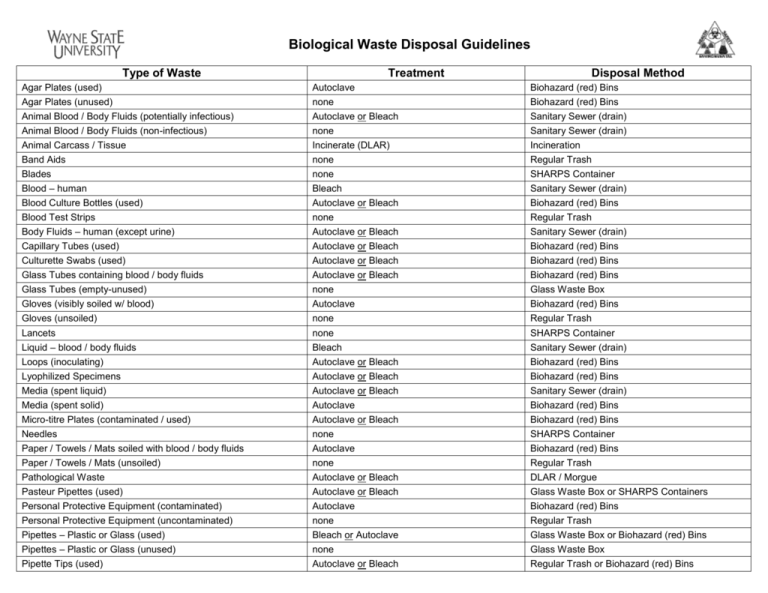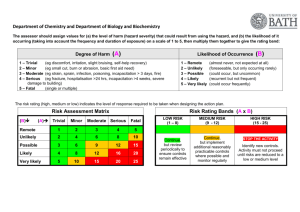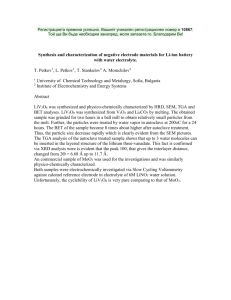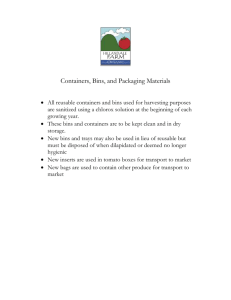Biological Waste Disposal Guidelines
advertisement

Biological Waste Disposal Guidelines Type of Waste Treatment Disposal Method Agar Plates (used) Agar Plates (unused) Animal Blood / Body Fluids (potentially infectious) Animal Blood / Body Fluids (non-infectious) Animal Carcass / Tissue Autoclave none Autoclave or Bleach none Incinerate (DLAR) Biohazard (red) Bins Biohazard (red) Bins Sanitary Sewer (drain) Sanitary Sewer (drain) Incineration Band Aids Blades Blood – human Blood Culture Bottles (used) Blood Test Strips Body Fluids – human (except urine) none none Bleach Autoclave or Bleach none Autoclave or Bleach Regular Trash SHARPS Container Sanitary Sewer (drain) Biohazard (red) Bins Regular Trash Sanitary Sewer (drain) Capillary Tubes (used) Culturette Swabs (used) Glass Tubes containing blood / body fluids Glass Tubes (empty-unused) Gloves (visibly soiled w/ blood) Gloves (unsoiled) Autoclave or Bleach Autoclave or Bleach Autoclave or Bleach none Autoclave none Biohazard (red) Bins Biohazard (red) Bins Biohazard (red) Bins Glass Waste Box Biohazard (red) Bins Regular Trash Lancets Liquid – blood / body fluids Loops (inoculating) Lyophilized Specimens Media (spent liquid) Media (spent solid) none Bleach Autoclave or Bleach Autoclave or Bleach Autoclave or Bleach Autoclave SHARPS Container Sanitary Sewer (drain) Biohazard (red) Bins Biohazard (red) Bins Sanitary Sewer (drain) Biohazard (red) Bins Micro-titre Plates (contaminated / used) Needles Paper / Towels / Mats soiled with blood / body fluids Paper / Towels / Mats (unsoiled) Pathological Waste Pasteur Pipettes (used) Autoclave or Bleach none Autoclave none Autoclave or Bleach Autoclave or Bleach Biohazard (red) Bins SHARPS Container Biohazard (red) Bins Regular Trash DLAR / Morgue Glass Waste Box or SHARPS Containers Personal Protective Equipment (contaminated) Personal Protective Equipment (uncontaminated) Pipettes – Plastic or Glass (used) Pipettes – Plastic or Glass (unused) Pipette Tips (used) Autoclave none Bleach or Autoclave none Autoclave or Bleach Biohazard (red) Bins Regular Trash Glass Waste Box or Biohazard (red) Bins Glass Waste Box Regular Trash or Biohazard (red) Bins Pipette Tips (unused) Razor Blades none none Regular Trash SHARPS Container Slides (fixed – used or unused) Slides (unfixed used or unused) Specimen Bags grossly soiled Specimen Containers with blood / body fluids Syringe containing blood / body fluids with or without needle Syringe without needle (not containing blood / body fluids) none none Autoclave Autoclave or Bleach (depending on volume) None None Glass Waste Box SHARPS Container Biohazard (red) Bins Biohazard (red) Bins SHARPS Container Biohazard (red) Bins Test Tubes containing blood / body fluids Tissue / Specimens (unfixed) Tissue / Specimens (fixed) Towel / paper / etc. soiled with blood / body fluids Tubes (used / contaminated) culture, vacutainer, microfuge Tubes (unused / uncontaminated) culture, vacutainer, microfuge Autoclave or Bleach Autoclave or Bleach none Autoclave Autoclave none Biohazard (red) Bins or Sanitary Sewer Biohazard (red) Bins Biohazard (red) Bins Biohazard (red) Bins Biohazard (red) Bins Biohazard (red) Bins Urine Samples Urine Transfer Pipettes / Specimen Containers / Test Strips none none Sanitary Sewer (drain) Regular Trash Contaminated: Materials contaminated with human or animal blood, body fluids, or other potentially infectious materials, including materials that contain bacteria, viruses, parasites, or fungi that can be transmitted to humans or animals. NOTE: Even if a material is known to be non-hazardous (i.e., blood from uninfected animals) it is impossible to distinguish from human blood or other infectious materials and has the appearance of being potentially infectious. Uncontaminated: Materials that are not contaminated with a potentially infectious substance, or materials that have been properly decontaminated by autoclave, bleach, or some other acceptable sterilization / decontamination method. Blood & Body Fluids: Any liquid blood or body fluids from humans or animals, excluding urine. Blood & Body Fluids Contaminated with Chemicals or Radioactive Materials: These must not go down the drain. Contact OEH&S for collection / disposal. Sanitary Sewer (drain) Disposal: Blood, body fluids, spent liquid media, and other potentially infectious liquids should be treated for 30 minutes with bleach before disposal down the drain. Red Biohazard Bins: Potentially infectious materials should be autoclaved, bleached, or treated in a manner which renders them non-hazardous before they are put into the red bins. Do not autoclave materials that have already been treated with bleach. BIOHAZARD BINS SHOULD NOT BE AUTOCLAVED. Broken Glass Boxes: All contaminated materials put into broken glass boxes should be autoclaved, decontaminated with bleach, or treated in another way which renders them non-hazardous. SHARPS should never be put into broken glass boxes, whether or not they are contaminated. Autoclave Treatment: Lab must buy autoclave bags. SHARPS containers, biohazard bins & liner bags are not autoclavable. Do not autoclave bleached items. SHARPS Disposal: Needles, razor blades, microtome blades, lancets, scalpels, etc. must ALWAYS be disposed of in a SHARPS container. Needles should never be recapped, sheared, bent or broken. The needle and syringe should be put into the SHARPS container as a whole unit, uncapped. SHARPS CONTAINERS SHOULD NEVER BE AUTOCLAVED. WSU Office of Environmental Health & Safety, 577-1200, www.oehs.wayne.edu 8/10






